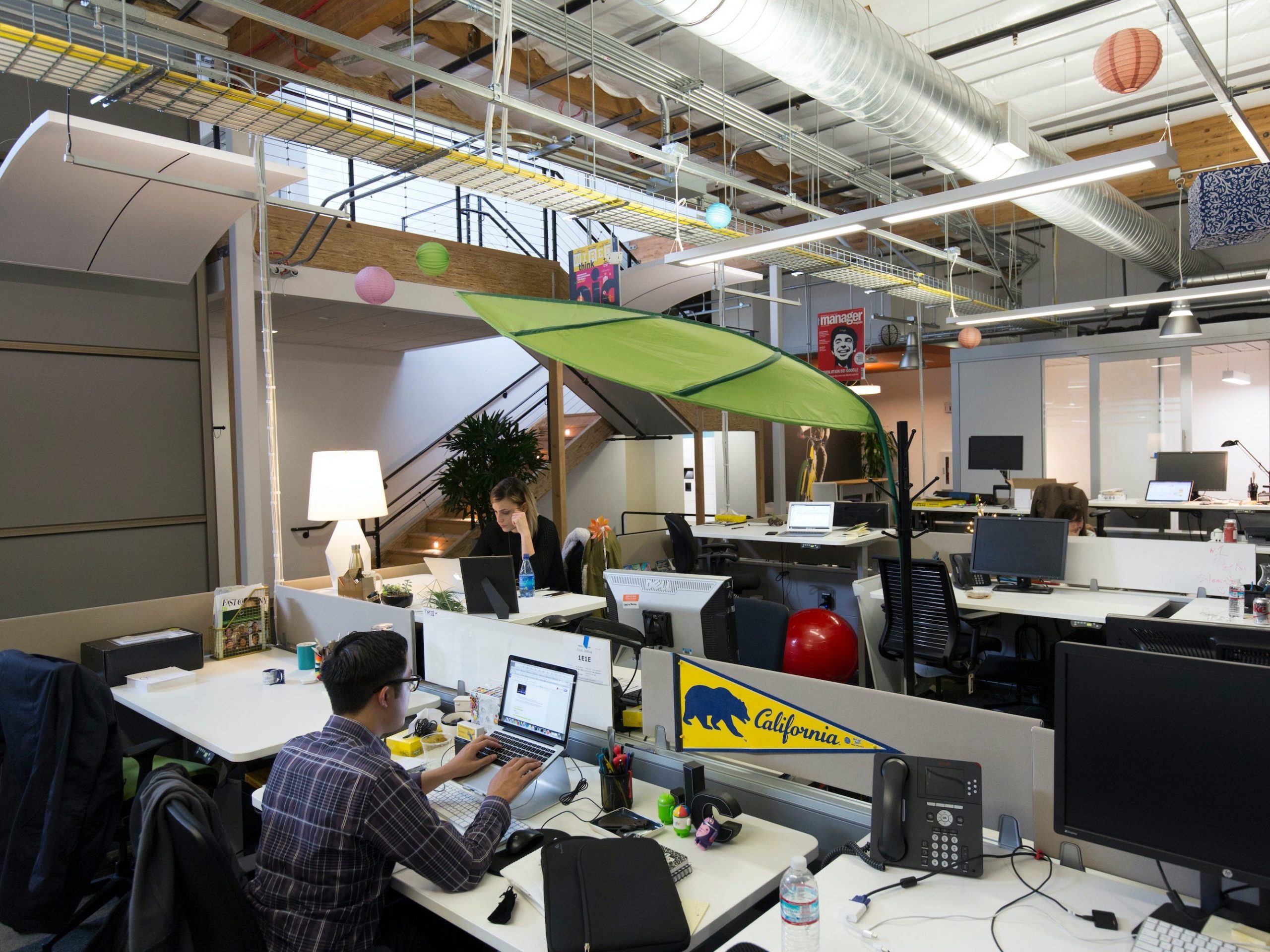- The coronavirus outbreak will have long-lasting effects on US workers, particularly when it comes to the open office made popular by Silicon Valley companies like Facebook and Google.
- Experts say that the open office was never very positive for employees, who reported feeling less productive and more distracted, got sick more easily, and felt pressured to work longer and harder because of their lack of privacy.
- When offices begin reopening, whether that’s this year or next summer, we’re likely to see a shift away from the open floor plan.
- “Open floor plans are most definitely going to disappear,” Rhiannon Staples, chief marketing officer at human resources management company Hibob, told Business Insider. “I feel like it was already on its way out and this was the kick it needed to get it out the door.”
- Visit Business Insider’s homepage for more stories.
As the coronavirus continues its spread, unabated, in many parts of the US, it’s becoming increasingly apparent that a return to “normal” is still far in the future. That’s true for American office workers, many of whom have been working from their homes since March.
But when workers are able to return to work en masse, whether that’s this winter or a year from now, the office probably won’t look as they left it.
Corporations nationwide are considering how to reopen spaces, from new ventilation systems systems to socially distanced elevators and closed-off kitchens. But the biggest change might be to the space as a whole.
Experts predict that the wide-open office, popularized by tech industry titans like Google and Facebook, will become a thing of the past. The fad, already becoming passé, has become almost dangerous in the face of the virus – employees often sit packed in large, open rooms, with desks placed close enough to reach out and touch your coworker.
But don't mourn the death of that open-office floor plan just yet: though it was once heralded as the key to employee collaboration and productivity, it was never all that great for workers anyway.
The rise of the open office

Beginning in the early aughts, American tech workers began leaving cubicles behind in favor of an open-floor-plan office space.
It all started with Google, which revealed its new headquarters, the Googleplex, in 2005. Based in Mountain View, California, it was - and still is - unlike any office in America. It had a bowling alley! And sleep pods! And even sand volleyball courts!
The Googleplex, with its open design and flexible spaces, was heralded as the future.
"The attitude was: We're inventing a new world, why do we need the old world?" Clive Wilkinson, the architect who designed the Googleplex, told Fast Company last year.
Soon, companies started coming to Wilkinson and saying they wanted to by like Google, he told Fast Company. Not long after, Facebook followed suit, opening what it says is the biggest open-floor-plan office in the world: approximately 2,800 employees working in "one giant room," CEO Mark Zuckerberg said when it opened in 2015.
"We saw a big pendulum shift where everyone came out of private offices and big cubicles into the open office, and that was an epic fail, because one size does not fit all. The open office has gotten a really bad rap as a result of doing it really badly," Melissa Hanley, CEO of the design firm Blitz, which counts Microsoft and Instacart among its clients, told Business Insider.
At the time, the idea was that if you broke down physical barriers between workers, it would break down metaphorical ones as well. Employees would be able to easily collaborate on projects and would be enticed to engage in a free-flow of ideas with their next-door neighbor. The company's CEO, once ensconced in a glass corner office, would now sit right out on the floor next to their employees, a person of the people.
But that's not exactly what happened.
Instead, employees put on headphones to shut out the noise that came along with wide-open spaces. They reported feeling stressed, anxious, and less likely to collaborate with those around them. In fact, a Harvard Business Review study from last year found that when a company switched to an open office, face-to-face interactions actually decreased by 70% - employees just communicated electronically instead.
And that wasn't the only problem. A prescient 2018 piece by Vice's Mark Hay argued that open offices are vectors for disease, with employees who work in them taking more sick days than those who work in enclosed offices.
"In the workplace, it only follows that if you're working in close proximity and handling objects and interacting closely with each other, it's a very easy route of transmission for germs, viruses, bacteria," Melissa Perry, a public-health researcher at George Washington University's Milken Institute School of Public Health, told Business Insider earlier this year.
Socializing productivity

But beyond the prevalence of germs, there's another downside of the open office, at least for employees.
"The open-plan office has always been in some ways in the interest of the company rather than the worker, because it socializes productivity," Melissa Gregg, Intel's chief technologist for user experience, recently told The New York Times. "It forces workers to watch each other's work, and it creates very few spaces of privacy for individual workers."
Mentally, there's a pressure that comes with open offices. Workers don't want to look like they're not working hard, or like they're ducking out early. As Jeff Pochepan argued in Inc Magazine in 2018, this means that workers may work longer hours or feel undue pressure to be "on" and engaged 100% of the time, since everyone can see them.
"I definitely think there's a concept within agile workplaces about accountability and thinking that you set something out that you're going to do and then you have to report back, did you do it," Hanley said. "I do think that the visual access to each other is probably feeding into that."
Tracy Brower, a sociologist and principal in the Applied Research + Consulting Group at furniture manufacturer Steelcase, likened open offices to manufacturing, where workers generally kept an even, steady pace until a "rate-buster" came in - someone who worked harder and faster, thereby pushing the whole group too much.
"There's hustle culture where, I may not actually be more productive, but by goodness, I'm going to stay later than my boss, no matter what," Brower told Business Insider. "I think we can get caught up in working for the sake of working and being busy for the sake of being busy."
'The kick it needed to get it out the door'

In the short term, the office is already changing. Companies are considering density like never before, spacing out workstations, limiting large groups in conference rooms and elevators, and placing partitions in between desks, almost like the cubicles of yore.
But these cosmetic alterations are likely to be the precursor to a bigger change. Even though a full return to the office still appears to be a long way off, experts agree that when we do return - perhaps in summer 2021, as Google and Facebook expect - we should expect some permanent changes.
"Open floor plans are most definitely going to disappear," Rhiannon Staples, chief marketing officer at human resources management company Hibob, told Business Insider. "I feel like it was already on its way out and this was the kick it needed to get it out the door."
But Brower said she doesn't think the open office is 100% dead - it's just going to feel different than it did in early 2020.
"The pendulum has really swung toward open, open, open, and lots of density," Brower said. "I think what has now happened is we're starting to swing that pendulum way to the other side - more barriers, more boundaries, less density."
While that mentality is critical for the safety of employees in the near future, Brower said she doesn't expect things to stay that way.
"I think what we will end up seeing is that pendulum landing somewhere a little bit close to the middle," Brower said. "This is actually our opportunity to reimagine, reinvent, use the coronavirus almost as an accelerator to get to places that are maybe even better than it would have been."

